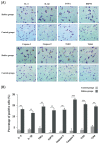Natural Infection with Rabies Virus: A Histopathological and Immunohistochemical Study of Human Brains
- PMID: 30847265
- PMCID: PMC6396821
- DOI: 10.24171/j.phrp.2019.10.1.03
Natural Infection with Rabies Virus: A Histopathological and Immunohistochemical Study of Human Brains
Abstract
Objectives: Despite all the efforts and increased knowledge of rabies, the exact mechanisms of infection and mortality from the rabies virus are not well understood. To understand the mechanisms underlying the pathogenicity of rabies virus infection, it is crucial to study the tissue that the rabies virus naturally infects in humans.
Methods: Cerebellum brain tissue from 9 human post mortem cases from Iran, who had been infected with rabies virus, were examined histopathologically and immunohistochemically to evaluate the innate immune responses against the rabies virus.
Results: Histopathological examination revealed inflammation of the infected cerebellum and immunohistochemical analyses showed an increased immunoreactivity of heat shock protein 70, interleukin-6, interleukin-1, tumor necrosis factor-alpha, caspase-3, caspase-9, toll-like receptor3 and toll-like receptor4 in the infected brain tissue.
Conclusion: These results indicated the involvement of innate immunity in rabies infected human brain tissue, which may aggravate the progression of this deadly disease.
Keywords: central nervous system; human; immunohistochemistry; pathology; rabies; tissue.
Conflict of interest statement
Conflicts of Interest The authors declare that there was no conflicts of interest associated with this paper.
Figures



Similar articles
-
Induction of immunoreactive interleukin-1 beta and tumor necrosis factor-alpha in the brains of rabies virus infected rats.J Neuroimmunol. 1996 Aug;68(1-2):45-51. doi: 10.1016/0165-5728(96)00056-2. J Neuroimmunol. 1996. PMID: 8784259
-
Attenuated rabies virus activates, while pathogenic rabies virus evades, the host innate immune responses in the central nervous system.J Virol. 2005 Oct;79(19):12554-65. doi: 10.1128/JVI.79.19.12554-12565.2005. J Virol. 2005. PMID: 16160183 Free PMC article.
-
Involvement of extraneural tissues and upregulation of inducible nitric oxide synthase after experimental infection with rabies virus in BALB/c mice and LEW/SsN rats.Pathol Int. 2012 Sep;62(9):619-27. doi: 10.1111/j.1440-1827.2012.02846.x. Pathol Int. 2012. PMID: 22924848
-
The role of toll-like receptors in the induction of immune responses during rabies virus infection.Adv Virus Res. 2011;79:115-26. doi: 10.1016/B978-0-12-387040-7.00007-X. Adv Virus Res. 2011. PMID: 21601045 Review.
-
Modulation of the immune response in the nervous system by rabies virus.Curr Top Microbiol Immunol. 2005;289:239-58. doi: 10.1007/3-540-27320-4_11. Curr Top Microbiol Immunol. 2005. PMID: 15791959 Review.
Cited by
-
Neglected and (re-)emergent infections of the CNS i n low-/middle-income countries.Infez Med. 2021 Dec 10;29(4):513-525. doi: 10.53854/liim-2904-3. eCollection 2021. Infez Med. 2021. PMID: 35146359 Free PMC article. Review.
-
Beneficial and Detrimental Effects of Regulatory T Cells in Neurotropic Virus Infections.Int J Mol Sci. 2020 Mar 2;21(5):1705. doi: 10.3390/ijms21051705. Int J Mol Sci. 2020. PMID: 32131483 Free PMC article. Review.
-
Molecular Mechanisms Associated with Neurodegeneration of Neurotropic Viral Infection.Mol Neurobiol. 2024 May;61(5):2881-2903. doi: 10.1007/s12035-023-03761-6. Epub 2023 Nov 9. Mol Neurobiol. 2024. PMID: 37946006 Free PMC article. Review.
-
Update on lyssaviruses and rabies: will past progress play as prologue in the near term towards future elimination?Fac Rev. 2020 Nov 16;9:9. doi: 10.12703/b/9-9. eCollection 2020. Fac Rev. 2020. PMID: 33659941 Free PMC article. Review.
-
A comparative analysis of the dendritic cell response upon exposure to different rabies virus strains.PLoS Negl Trop Dis. 2025 Apr 10;19(4):e0012994. doi: 10.1371/journal.pntd.0012994. eCollection 2025 Apr. PLoS Negl Trop Dis. 2025. PMID: 40208887 Free PMC article.
References
LinkOut - more resources
Full Text Sources
Research Materials

